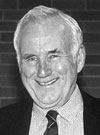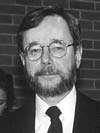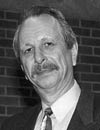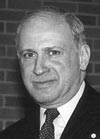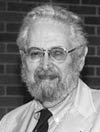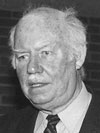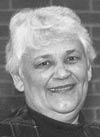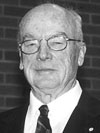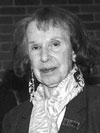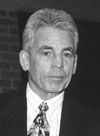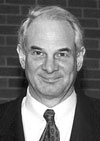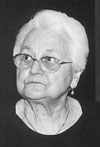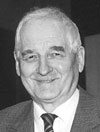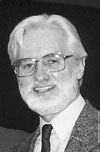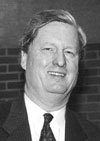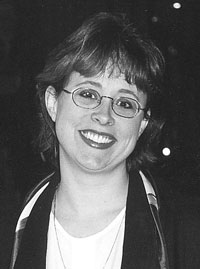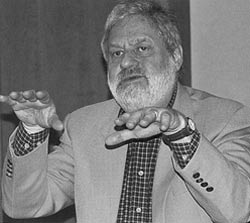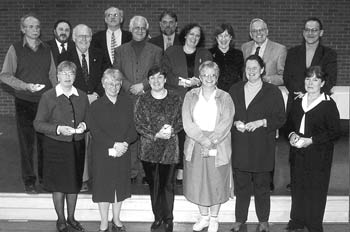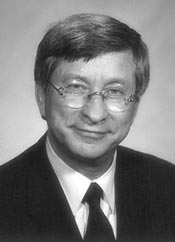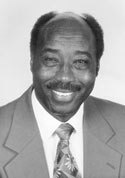
|

|
| | |
| | VOLUME 30, NUMBER 24 | WEDNESDAY, MARCH 22, 2000 | ISSN 1199-5246 | | |
| | ||||||||||||||||||||||||||||||||||||||||||||||||||||||||||
|
|
By Susan Scott Urban planners and academics, primarily from southern Ontario, gathered at York recently to discuss the impact of ethnic diversity on the landscape - literally - specifically, the changing mosaic of the Greater Toronto Area (GTA). During the one-day conference, the approximately 90 attendees listened to panelists from Vancouver and from Bonn, Switzerland, a representative from the federal government Department of Citizenship and Immigration Canada and a York geography professor. Marcia Wallace, a professor of urban studies at York, organized the first-of-its kind conference at the University to bring together professionals and academics to discuss an issue that shouldn't really be new, especially to those living and working in multicultural cities and towns, but nonetheless "hasn't hit the screen" for many in the business, according to Wallace. She garnered support from her department and the University's Faculty of Arts. She also received support from the GTA Forum, a group of people and organizations interested in events and trends in the GTA, and Metropolis, a project of Citizenship and Immigration Canada and several other federal government departments, designed to improve policies for managing migration and diversity in major Canadian cities. "This conference was a good first step," said Wallace, in introducing people who work in urban planning to ideas they might not consider when doing their day-to-day work. They also got an opportunity to meet colleagues and researchers in urban planning and learn about trends in the field. For example, Wallace said, more than one speaker drilled home the message that multiculturalism, or diversity, is part of all planning and shouldn't be separated from other functions. Wendy Au, one of the panelists, is a multicultural planner for the City of Vancouver. Wallace explained that Au challenged conference attendees to rethink the notion of multicultural planning. Part of Au's work is with a specific revitalization project in east Vancouver. There, she said, diversity is a much broader term which also includes economic and social culture. Au said her office involves other city departments in the planning process - building inspection and health, for example - so that planning is integrated. "Toronto doesn't have a multicultural planner," said Wallace, "so it was useful to hear Wendy's experience." One of the other speakers, Andreas Wimmer, from the University of Bonn, compared and contrasted a number of policies in different European cities. For instance, Wimmer discussed race relations policies and ways in which cities provide services to new immigrants to a city. Wallace said Wimmer illustrated that "there's no one answer" but there might be common threads and best practices that planners can share with each other. There was also some discussion about how to build flexibility into the planning process. For example, Scarborough (formerly a municipality, now part of the City of Toronto), was a planned community. Wallace said it was planned using "assumptions" of the 1950s family. Those assumptions, however, don't necessarily fit today's multicultural needs. "The challenge is to be sensitive to diversity while not boxing yourself in while planning," said Wallace. Moreover, different cultures use space differently and there's a question of how far to go to accommodate change. If planning is done today with one culture in mind, will other cultures be excluded from that planning model in the future? Wallace said for those who couldn't attend the conference, she is preparing a package that includes the conference presentations plus some "critical commentary" that will draw conclusions and put issues in context. "We want to provide some value-added" information for people, she said. As well, the issue of multicultural planning and highlights from the York conference will be explored in an upcoming issue of Plan Canada, the national trade magazine for planners.
| |||||||||||||||||||||||||||||||||||||||||||||||||||||||||
|
|
York inducts incoming members of Founders' Society By Cathy Carlyle The York University Founders' Society is a new honour recognizing those who made major contributions to the University during its founding years (1957 - 1965). Inductions into the Founders' Society have been made on several occasions during York's 40th anniversary year. "We are celebrating two special groups of people who are very important to York University now and in the future," said York President Lorna Marsden at a luncheon in March. "One group is being inducted into the Founders' Society. These are people who are part of the initial University. Those in the other group have been here for 25 years and are also extremely important. We congratulate you all." Vice-President Advancement Gary Smith added his own congratulations to the honorees and spoke fondly of his days as an undergraduate at York in the 1960s. "I'm pleased to be here. I see some people here who were father figures to me - though they look somewhat younger these days," he quipped.
| |||||||||||||||||||||||||||||||||||||||||||||||||||||||||
|
|
Radio tour touting Canadian universities gets US attention
By Cathy Carlyle Joanne Duklas Joanne Duklas has been on a new-age radio tour - a virtual tour, and a very successful one at that. She was interviewed, sometimes live and sometimes taped, on 14 national and local radio stations in the United States over a period of three days in December. All this occurred from the comfort of her own home in Toronto. Duklas, York University assistant director of international liaison in the Office of International Admissions, was chosen as spokesperson, representing the Association of Registrars of Universities and Colleges of Canada (ARUCC). The tour was sponsored by the federal government, and initiated and organized through the Canadian Embassy in Washington, DC. "We wanted to raise awareness about the quality of education in this country, and present a broad perspective on all universities in Canada," she explained. "This was the first time something like this had taken place in the US for Canadian universities. ARUCC was very appreciative of the proactive support of the Canadian government. The initiative was similar to the Team Canada concept. Our universities need the support of the government in the area of international student recruitment, and we welcome its active participation in the internationalization efforts of Canadian schools." Duklas said the radio discussions were targeted at parents who were looking for quality and affordability for their children who were preparing for university studies. Approximately 3.6 million listeners tuned in to the shows. "Although it is always difficult to measure the impact with this type of medium, our initial impressions are very good," she said. "By the end of each program, the interviewers were positive about the Canadian study option and usually ended by saying things like, 'This is a good deal, folks. There is quality education in Canada'. One station who recognized the obvious advantages for American parents and their children suggested we return in the Spring. As well, Canadian Embassy staff said they noticed an increase in the number of 'hits' at their Web site after the broadcasts." Why would Americans be tempted to attend a Canadian university? Duklas said big drawing cards are the relatively low tuition coupled with the opportunity to take a four-year degree in a safe, international environment. Program uniqueness also attracts students. "The international tuition fee rates in Canada are comparable to US state tuition and much more reasonable than US private university fees. For Americans looking for quality education at an affordable price, Canada is a very viable option." She said audiences were interested to know that students may take a three-year degree in Canada and be ready for employment, or complete a four-year degree program and be eligible for graduate studies at US universities, including Yale and Harvard. "By way of example, last year over 280 Canadian graduates were studying at Harvard. One topic that was on many people's minds was Quebec and what would happen to Canada if the province seceded. They wondered, too, if all students were required to speak French. "I was a little surprised by the lack of knowledge out there about Canada and our universities," said Duklas, "especially after how much work has been done by the Canadian Embassy in Washington and by the individual universities." She said the Canadian Embassy, ARUCC and universities in this country are hoping to gain wider publicity through the print media in the US. Canadian universities already have had positive coverage in a number of US newspapers and magazines, including a November 1999 Time Magazine article. All emphasized the value and quality of a Canadian degree. Duklas noted that, "As a result of our collective and individual efforts, we have seen growth in American interest in our universities. We are very excited about seeing this continue." Almost 4,000 Americans are pursuing four-year degrees in Canada this year, an increase of nearly 1,000 over last year.
| |||||||||||||||||||||||||||||||||||||||||||||||||||||||||
|
|
York has dynamic recruitment program The American students at York do not appear by magic or good luck. It takes dedicated staff and faculty and a huge group effort to get the word out about the University's numerous attractions. "We're working hard to raise the York profile in the United States," said Joanne Duklas. "The number of US high schools (about 26,000) and the size and competitiveness of the US postsecondary environment make this an exciting challenge. However, our efforts are obviously working, given a more than 40 per cent increase in US applicants to York in the last year alone." She said everyone engaged in international recruitment at the University raises awareness in the US in several ways: * participation in US education fairs * direct mail campaigns targeted at US guidance counsellors, students and parents * personal visits to schools * advertisements and articles in US publications, newspapers, Web sites and CD ROMs * working with York alumni currently living in the US * hosting US guidance counsellors, students and parents, and connecting them with York Faculties * encouraging faculty to accompany admissions staff at presentations about York and to help host groups at the University * delivering an extensive on-campus program Another way Admissions raises awareness about York in the US and elsewhere is by building on positive word-of-mouth through the Take York Home (TYH) program. "TYH is a volunteer program," explained Vanessa Grafi, international recruitment officer and the program's manager. "We ask York students travelling to their home country to share information about the University with their former high schools, universities or colleges. Our goal is to let people with an interest in international postsecondary study know how exciting, diverse and academically outstanding York is." Professors attending conferences abroad also are encouraged to spread the word about York by taking material about the University to share with colleagues, she added. "Word-of-mouth is working in our favour," said Duklas. "Current international students and alumni, who have returned or moved to the US, spread positive news about the University. We also have the support of York professors and staff who work hard to promote their academic programs and services. And our office, working with the central Office of Admissions and the people involved in the International Action Group, chaired by Deborah Hobson [vice-president, enrolment and student services] ensure that a coordinated, pan-university approach to international recruitment occurs." Recently, York's international recruitment program received honourable mention by the Association of Universities and Colleges. "On a more practical and telling front, our work in the US has directly influenced a solid increase in US undergraduate applicants. Team York is making an impact," said Duklas.
| |||||||||||||||||||||||||||||||||||||||||||||||||||||||||
|
|
York stats to boast about * Students from more than 150 countries study at York * York students regularly win international awards including the Rhodes Scholarship, Fulbright Scholarship, Mellon Fellowship, Commonwealth Scholarships, Canada Memorial Foundation Scholarships and Queen Elizabeth Silver Jubilee Awards * Five York professors have won 3M Teaching Awards - Canada's top teaching award * The Faculty of Fine Arts is the only Faculty of its kind in Ontario and one of the largest and most comprehensive in North America. Our jazz program is cited as the best in Canada by external review * The Schulich School of Business developed the first international MBA program in Canada. It is a past winner of the Association of Universities and Colleges award for excellence in the area of internationalization (two years running) * York is the only Ontario university to offer a bachelor of design degree * The Faculty of Environmental Studies offers one of the largest programs in that field in North America * York's Faculty of Arts has the largest concentration of humanities and social science researchers in Canada - 794 in all * York developed the first PhD in Women's Studies in Canada and has one of the world's largest School of Women's Studies * The Faculty of Graduate Studies is one of the largest in Ontario. Over 100 PhDs are granted each year to successful scholars in traditional and interdisciplinary programs * Osgoode Hall Law School is Ontario's largest and oldest law school * Glendon is home to the Canadian Institute of International Affairs and to the internationally-renowned publishing house, Éditions du Gref
| |||||||||||||||||||||||||||||||||||||||||||||||||||||||||
|
|
Kater discusses criminal physicians in the Third Reich
By Cathy Carlyle Josef Mengele is a name with which most people are familiar. He was a Nazi doctor infamous for his heinous experiments on Auschwitz prisoners in World War II. Yet Mengele is just one of many criminal doctors active in the time of the Nazi regime. Distinguished Research Professor of History Michael Kater, at the Canadian Centre for German and European Studies, raised the question of whether the individual guilt of what was reputed to be "a few" criminal doctors would justify branding the entire profession as criminal during the Third Reich. "I believe it is possible to find a critical mass of evidence to make the case that they displayed a proclivity for political and ethical wrongdoing," he said at a recent Brownbag seminar. However, he said the question remains open until further research has been undertaken, as to whether or not the physicians as a group legitimately could be branded as "evil". In their political association, they were culpable, said Kater, because, without pressure, they were over-represented in a number of Nazi organizations, including the Nazi Physicians' League, the Nazi Party, the Storm Troopers (SA) and the elite SS. "Large on the agenda of the Nazi Physicians' League was anti-Semitism. Many German doctors believed that Jewish physicians were over-represented in their profession," he said, adding that unemployment among non-Jewish doctors was about 10 per cent prior to Hitler's coming to power in 1933. "Hence, even in the early 1930s joining the league was predicated on sincere or opportunistic adherence to Judeophobia." The League, often serving as a social club, collaborated with Nazi cultural organizations in spreading Nazi cultural propaganda. It also disseminated biological information on those Jewish colleagues still allowed to practise medicine, and later went a step further when it set up a Nazi leadership school. There, Nazi biopolitical values on eugenics, as well as Nazi medical education, were instilled in League members. "By 1939, the League had been eclipsed in importance by the Nazi Party itself, and nearly 45 per cent of all doctors in Germany joined it over the span of the Third Reich," said Kater. Moreover, 26 per cent of all male doctors became members of the SA in the Nazi period. After Hitler purged the SA in 1934, suspecting it of revolt, the elite SS became preeminent, which meant that many SA physicians went over to it. "Eventually seven per cent of the physicians became SS comrades," said Kater. "In absolute terms this figure is low, but it must be remembered that the SS was artificially kept small in order to justify its elite claim. Compared to other professions the doctors were hugely over-represented there: not even half a per cent of teachers was in it and only three per cent of all musicians. Only lawyers had a higher representation." Why were so many doctors attracted to the SS, queried Kater, other than for its exclusivity? For the SS doctors, knowing the elite group's power over life and death, "death now assumed a more versatile quality in that it might be used in a threatening manner." He said that new "ethical" norms now superseded traditional ones such as the Hippocratic Oath. National Socialism was based on crude notions of Darwinism, whereby "Aryans" were considered superior to "non-Aryans". The latter group included Jews and Gypsies. They, along with people who were congenitally diseased, were selected for extermination. Kater launched into a brief history of some of the lesser-known, but nonetheless criminal, physicians who were active during the Third Reich. The following is a selection: * Theodor Steinmeyer, psychiatrist and Nazi "hack"; judge in one of the regional hereditary-health courts, determining which patients should be sterilized, castrated or transferred to a psychiatric hospital and later killed; active in the "euthanasia" killing schemes * Werner Sengenhoff, psychiatrist long loyal to the Nazi movement; instrumental in euthanizing institutionalized babies and toddlers * Ernst Günther Schenck, member of the armoured wing of the SS and responsible to the head of the concentration camp system; experimented with food products, made from a cellulose derivative consisting of refuse, and fed to camp prisoners, some of whom died * Kurt Heissmeyer, Nazi Party member; did research into a cure for tuberculosis (TB), used Jewish children from Auschwitz as guinea pigs for his experiments; wrongly believed TB was traceable to the "congenitally defective constitution of the patient" * Johann Paul Kremer, camp physician at Auschwitz and member of the SS; selected camp inmates for the gas chambers; took human liver, spleen and pancreas of recently-killed chamber victims for analysis * Herta Oberheuser, Nazi Party member and doctor at a special concentration camp for women; used inmates for gas gangrene experiments, cutting deep into their legs and arms and injecting them with bacteria and sulfonamide; assisted colleagues in bone transplants, observing how the then-crippled women moved - if they survived. What commonalities did the Nazi doctors have? Kater presented several: a number wanted to advance themselves in their jobs, using Party membership as a way; many used their positions for further scientific research in order to raise their status; for some, sadism may have been a motive; in fact, sadism and scholastic aspirations may have overlapped; female doctors may have been competing with males in a misguided quest for emancipation, to prove their worth in the Third Reich; and some may truly have believed in the inferiority of "non-Aryan" peoples. Work lies ahead, he said, for scholars to examine why so many German doctors took Nazi ideology seriously, "to determine the size of that plurality and render it measurable and comparable, expressed as a number, a ratio, vis-à-vis other Nazi, or German, doctors, or against all Nazis or the German population as a whole. These are just some of the tasks awaiting present-day researchers." Kater said that, although medical-history courses regarding abuses during the Third Reich still are not mandatory in German medical schools, today there is an awareness that "a lot was wrong with the medical culture in Germany between 1914 and 1945, particularly among younger physicians. There is a growing, credible literature on the abuses of the past," he added, "while on the other hand, the teaching of the entire subject of medical history still leaves much to be desired." Even in North America the subject of Nazi medical theory and practice tends to be absent from the curricula of medical schools and research institutes, he said. He worries that risky medical experiments, such as those performed by doctors during the Third Reich, might still be performed. "Those of us who do not learn from the past will be condemned to repeat it," he warned. Kater's book, Doctors Under Hitler (1989), has just been released in paperback.
| |||||||||||||||||||||||||||||||||||||||||||||||||||||||||
|
|
Celebrating 25 years of service to York University
| |||||||||||||||||||||||||||||||||||||||||||||||||||||||||
|
|
Schulich among top business schools in global Financial Times ranking
By Cathy Carlyle Dean Dezsö Horváth of the Schulich School of Business he Schulich School of Business at York was ranked among the top business schools in the world by a recent Financial Times survey. Schulich placed 45th overall among 75 schools in the highly-regarded survey, and was one of only four Canadian schools that made the global ranking. The others were the Ivey School of Business, The Rotman School of Business and McGill School of Business. "It's an exclusive club to be in and it's very important to be there," said Dezsö Horváth, Dean of the school. "There are over 2,000 business schools worldwide, and this ranking means we are among the top 50, the top two per cent in the world. I see it as a tremendous accomplishment." It was the first time the Schulich School of Business had been part of the Financial Times annual survey, in which participation is on an invitation-only basis. Horváth said it is important for schools to take part in such surveys, but cautioned that they should be seen for what they are - as only one measure among many. For instance, the survey did not take into account Schulich's pioneering program in which students may take their MBA on a part-time or full-time basis, he said. "Typically, an MBA takes two years and must be strictly full-time or part- time. However, at Schulich you may enter as a full-time student and become part-time later, or vice versa. The Financial Times survey considered only those students who were full time." In addition, Schulich might have had a higher rating if some of its innovative programs had been taken into account. In the research category, the survey focused on only the traditional core element of business, not on the frontiers pursued at the school. "We deal with business ethics, the environment, corporate governance, non-profit management and so on - all new areas in management education," said Horváth. There were other areas in which Schulich shone. Out of the 20,000 1996 alumni sent questionnaires by the Financial Times, 30 reported earning more than $500,000 (US) a year. Of those, only two in the world are from outside the leading 10 schools in the United States. One is from Insead, a top-ranked school in Europe; the other is a graduate of Schulich, with an annual salary of $629,000 (US). Also, Schulich had the third highest percentage of female students in the world, at 41 per cent. Horváth credited the school's newer programs and the flexibility found among all the programs, for attracting a large number of women. In particular, he cited several of the school's specialized programs, including the International MBA, Arts and Media, and Nonprofit Management and Leadership. Horváth said that the school has fared well in a number of surveys during the past, including a survey late last year conducted by Canadian Business magazine.
| |||||||||||||||||||||||||||||||||||||||||||||||||||||||||
|
|
How Schulich ranks in Canada In the October 29, 1999 issue of Canadian Business, the Schulich School of Business ranked second in Canada behind the Ivey School of Business among two-year MBA programs offering the best value for money. Schulich was also one of the top schools surveyed when it came to the percentage increase in salaries for MBA graduates. The survey measured the average entering salary of Schulich MBA students ($41,000) and the average starting salary following graduation ($80,600). The increase was a staggering 97 per cent. Schulich MBAs had the second highest average starting salary in Canada, closely followed by the Ivey School of Business. They were the only two schools in the country with an average starting salary of more than $80,000. Schulich had the highest earning MBA graduate: Steven Whatmore, an e-commerce consultant, was tops in Canada with a salary of $296,000.
| |||||||||||||||||||||||||||||||||||||||||||||||||||||||||
|
|
How corporate partnerships affect research at universities By Susan Scott University researchers may increasingly find themselves thinking like business people as they compete more rigorously for funding for projects from government or corporate sources. That was one conclusion voiced, although not necessarily universally endorsed, by attendees at a recent symposium on "Pressures Towards the Commercialization of University Research" at McLaughlin College. The symposium was organized by York's Centre for Practical Ethics, and was the third in a series of symposiums this year led by the Centre. Tom Wilson, a professor in the Public Administration Program at York's Osgoode Hall Law School, and a symposium panelist, lamented the trend towards researchers' increasing reliance on funding for their projects. "We're becoming addicted to research grants," he said. He is worried about the move away from peer-reviewed work towards a new "commercializability" of research that focuses on the financial carrot as the prime motivator to launch a project. He is also concerned about a "point system" whereby researchers might be required to amass a certain number of points to gain funding for projects. He pointed to a May 1999 report released from the federal government's Department of Science and Technology that discusses this notion. Another panelist, Graham McKechnie, a York economics professor, argued that faculty members need to be free from the corporate pressures to be able to independently test their hypotheses and release their findings. He said a proposal for "points" for research is the "real dilemma. Given the drift toward commercialization, can we erect any protective devices, and do we want to do so?" He called for York to consider these "protective devices" that would serve to shield researchers from undue corporate influence over their work, although he surmised it was already too late to suggest such a course of action. On the other hand, he said, at least the University would be setting its own "rules" about what it will or will not accept regarding future corporate donations. Peter Alexander, a master's student in the Public Administration Program at York's Schulich School of Business, was also on the panel. He said that the number of students registered in Schulich's Public Administration Program is quite low. The emphasis in the business school seems to be on students training for positions in the private sector. He questioned whether this apparent imbalance "doesn't always support the mission of the school. It's not hostility but concern that public administration studies will "atrophy because of neglect". He said there are a number of student clubs for marketing and finance programs but none for public administration, something he is trying to advocate. "I believe in dissecting problems and suggesting solutions," said Alexander. He would like to see more opportunities for students like him to have "space" at the University free from "commercial pressure" and suggested that more speakers from the public sector be invited to speak to students. The final speaker, Bill Woof, a member of York's Graduate Student Association (GSA) called for more "transparency" by University officials in releasing information after signing agreements with corporations that make donations to York. He said faculty, staff and students should be aware of the details of the terms of such agreements. Earlier this month, the University's Graduate Program in English also tackled the subject of corporatization in a kick-off to a series in the "Corporatization in the Academy Forum", specifically looking at its impact on English and Humanities. Speakers at the symposium held at Stong College included faculty from both University departments.
| |||||||||||||||||||||||||||||||||||||||||||||||||||||||||
|
|
York French Studies prof to deliver Fulbright lecture in Michigan
Ibrahim H. Badr, a professor of French studies at York, will deliver the Fulbright lecture at the annual foreign lecture series at Michigan's Ferris State University on March 30. He will lecture on "The New Face of a Changing World: Personal and Global Issues." A group of faculty at Ferris, called the Ferris Fulbrighters, work to bring foreign scholars to campus, particularly those who have a Fulbright connection. The lecture series, now in its eighth year, is aimed at raising international issues and topics to students and faculty, to promote global awareness and to further the ideas of J. William Fulbright, after whom the lecture is named. Fulbright was a United States senator from Arkansas. During the 1940s and 1950s, he was Chair of the US Senate Foreign Relations Committee. In 1992, Badr received a Fulbright Senior Scholar Award, in the university lecturer/ advanced research category, at Michigan State University. He has taught French language and literature at York since 1993. In 1999, he received the York Parents Association University-Wide Teaching Award for contract/part-time faculty. Badr's second book, Giono et la Guerre: Idéologie et Imaginaire, about the life and work of writer, Jean Giono, has just been published by Peter Lang.
| |||||||||||||||||||||||||||||||||||||||||||||||||||||||||
|
|
40Th Anniversary Reflections As we approach the end of the 40th anniversary year on March 25, it is a time to reflect on past accomplishments and look to the future. The 40th anniversary steering committee - Gary J. Smith, Chair, Lorna Marsden, Andre Beaudry, Sylvia Zingrone, John Lennox, Jessie-May Rowntree, Sine Mac-Kinnon, Diana Crocker, Joe Green, Ross McMillan, Alain Baudot, Kent Haworth, Ijade Maxwell, and Patrick Cardarelli - has delivered many activities and events during the year-long celebration. The activities and publications for the 40th anniversary have had a positive impact on York's public profile. We would like to take this opportunity to thank everyone who took part in this memorable event. We look forward to the opportunity to continue to build pride in our University through future initiatives, and await with anticipation the opening of the 40th anniversary time capsule in 2009-York's 50th anniversary year.
| |||||||||||||||||||||||||||||||||||||||||||||||||||||||||
|
|
Call for Nominations
Deborah Hobson, vice-president (enrolment & student services) invites nominations from faculty, staff and students for the Gene Denzel Award for Outstanding Service to Students. This award was established in 1998 on the occasion of Gene Denzel's retirement as associate vice-president (technological services & registrar), in recognition of his many contributions to the Registrar's Office and the University. This honour is to be awarded annually to a full-time member of the staff in the Registrar's Office who has gone above and beyond the call of duty in providing outstanding service to students. Nominations must be submitted in writing to the Office of the Vice-President (Enrolment & Student Services), Room N904 Ross Building by Friday, April 7, 2000. Letters of support (no more than three) may be included.
| |||||||||||||||||||||||||||||||||||||||||||||||||||||||||
| | Current Issue | Previous Month | Past Issues | Rate Card | Contact Information | Search |
|
